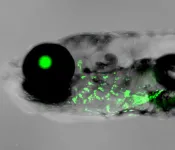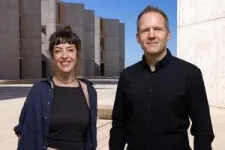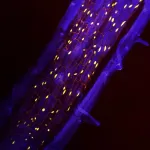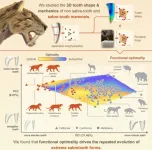(Press-News.org)
The outer ear is unique to mammals, but its evolutionary origin has remained a mystery. According to a new study published in Nature from the USC Stem Cell lab of Gage Crump, this intricate coil of cartilage has a surprisingly ancient origin in the gills of fishes and marine invertebrates.
“When we started the project, the evolutionary origin of the outer ear was a complete black box,” said corresponding author Crump, professor of stem cell biology and regenerative medicine at the Keck School of Medicine of USC. “We had been studying the development and regeneration of the jawbones of fishes, and an inspiration for us was Stephen Jay Gould’s famous essay ‘An earful of jaw,’ which laid out how fish jawbones transformed into the middle ear bones of mammals. This made us wonder whether the cartilaginous outer ear may also have arisen from some ancestral fish structure.”
The first clue toward cracking this mystery was the team’s discovery that gills and outer ears are both composed of a relatively rare tissue type: elastic cartilage. “When we started the study, there was very little out there about whether elastic cartilage existed outside of mammals,” said Crump. “So it wasn't really known if fish had elastic cartilage or not. It turns out that they do.”
Gills and outer ears look and function quite differently from one another. They also do not mineralize, which means they are rarely recovered in the fossil record. Therefore, a new type of approach was needed to determine if they were evolutionarily related. The study’s first author Mathi Thiruppathy, a PhD student in the Crump lab, focused on gene control elements called enhancers. While the genes that these enhancers control are often involved in the development of many unrelated tissues and organs, enhancers tend to be much more tissue specific.
The scientists were able to incorporate enhancers that help form the elastic cartilage of the human outer ear into the genomes of zebrafish . Remarkably, the human outer ear enhancers were active specifically in the gills of these transgenic zebrafish. The scientists also succeeded in doing the experiment in reverse, creating transgenic mice with genomes incorporating zebrafish enhancers typically involved in the formation of the gills, and found them active in the outer ears of the mice. These enhancers were key in connecting structures that at first glance do not appear to be very similar.
With collaborators, the researchers then investigated whether the human outer ear and fish gill enhancers could be used to follow the evolution of gills into outer ears across intermediate species, such as amphibians and reptiles. They found that when either human ear or fish gill enhancers were incorporated into the genomes of tadpoles, the enhancers showed activity in their gills. However, when reptiles came on the scene, the elastic cartilage of gills moved to the ear canal, which the scientists demonstrated in a series of experiments with green anole lizards. This cartilage eventually became further elaborated to form the prominent outer ears of early mammals.
An additional surprise was that the elastic cartilage of gills may have arisen much earlier than previously thought. Older reports had characterized cartilage-like tissue in the gills and tentacles of several marine invertebrates, including horseshoe crabs, which have changed very little since emerging close to 400 million years ago. The researchers performed DNA sequencing on individual cells of the horseshoe crab gills and discovered a crab enhancer that, when placed in the genome of zebrafish, had gill activity. This suggests that the very first elastic cartilage, similar to what is in our outer ears, may have first arisen in ancient marine invertebrates.
“This work provides a new chapter to the evolution of the mammalian ear,” said Crump. “While the middle ear arose from fish jawbones, the outer ear arose from cartilaginous gills. By comparing how the same gene control elements can drive development of gills and outer ears, the scientists introduce a new method of revealing how structures can dramatically change during evolution to perform new and unexpected functions.”
About the study
Additional authors are Lauren Teubner, Ryan R. Roberts, Seth Ruffins, Arijita Sarkar, Jade Tassey, Denis Evseenko, and Thomas P. Lozito from USC; Micaela Lasser and Helen Rankin Willsey from the University of California, San Francisco; Alessandra Moscatello and Ya-Wen Chen from the the Icahn School of Medicine at Mount Sinai; Christian Hochstim from Children’s Hospital Los Angeles and USC; and J. Andrew Gillis from the Marine Biological Laboratory at Woods Hole.
Funding was provided by NIDCR (grant numbers R35DE027550 and F31DE030706). Lizard experimentswere funded by NIH/NIGMS (grant number R01GM115444). Human tissue experiments were funded by USC Stem Cell Challenge Grants. Helen Rankin Willsey is a Chan Zuckerberg Biohub Investigator.
END
Scientists have called for the designation of a new United Nations Sustainable Development Goal (SDG) with the aim to conserve and sustainably use Earth's orbit, and prevent the accumulation of space junk.
There are currently 17 SDGs, adopted by UN members in 2015 as a universal call to action to end poverty, protect the planet for future generations, and ensure all people enjoy peace and prosperity.
But with growing numbers of satellites and other objects now orbiting our planet, there is growing concern that without some form of global consensus ...
Researchers have uncovered how egg cells prepare for the creation of life. Their work reveals the secrets of the Balbiani body, a remarkable structure that organizes essential molecules to guide early embryonic development. Using zebrafish models and cutting-edge imaging, the team discovered how this structure transforms from liquid droplets into a stable core, laying the groundwork for life itself. This discovery sheds light on the extraordinary precision of nature’s reproductive process.
A new study led by Prof. Yaniv Elkouby and his team, including first co-authors Swastik Kar and Rachael Deis, from the Faculty of Medicine at the Hebrew University ...
PHILADELPHIA—Opioid misuse and specifically opioid use disorder (OUD), continues to represent a significant U.S. public health threat, with more than 6 million Americans aged 12 and older meeting the criteria for OUD in 2022. Efforts to ease the crisis have included the development of genetic testing to identify individuals most at risk for OUD. New research, out today in JAMA Network Open, questions the usefulness of 15 genetic variants from an algorithm meant to predict OUD risk that was recently granted pre-marketing approval by the Food and Drug Administration. It found that the testing could lead to both false positive and false negative results.
The study was led by Christal ...
LA JOLLA (January 9, 2025)—Plants may burrow into the ground and stretch toward the sun, but they’re ultimately stuck where they sprout—at the mercy of environmental threats like temperature, drought, and microbial infection. To compensate for their inability to up and move when danger strikes, many plants have evolved ways to protect themselves by altering their physiology, such as building armor around parts of their body and roots called the periderm. However, since many plant biologists who study tissue development ...
Sabre-toothed predators – best know from the infamous Smilodon – evolved multiple times across different mammal groups. A new study, published today in Current Biology reveals why: these teeth were ‘functionally optimal’ and highly effective at puncturing prey.
The study, led by scientists at the University of Bristol in collaboration with Monash University shows that long, sharp blade-like teeth gave sabre-tooth’s a real advantage as ...
Russell W. Jenkins, MD, PhD, a physician investigator in the Krantz Family Center for Cancer Research at the Mass General Cancer Center and an assistant professor of Medicine at Harvard Medical School, is senior author of a new study in Cancer Immunology Research, “TBK1 is Identified as a Therapeutic Strategy to Enhance CAR T-Cell Efficacy Using Patient-Derived Organotypic Tumor Spheroids”.
The study was a collaboration with the late Soldano Ferrone, MD, PhD, and was carried across the finish line by his daughter Cristina Ferrone, MD, Moshe Sade-Feldman, PhD, and several other collaborators ...
Which medicine is best when you are affected by cancer? This can vary from person to person. A new method can help people with a specific type of blood cancer get the best medicine for them.
“The new method can help those affected by chronic myelogenous leukemia,” says Jennifer Sheehan, a PhD research fellow from the Department of Mechanical Engineering and Production at the Norwegian University of Science and Technology (NTNU). Sheehan was first author of a new publication in PLOS Computational Biology that describes ...
Miami (January 9, 2025) – Additional research addressing the connection between chronic obstructive pulmonary disease (COPD) and metabolic syndrome is needed to improve holistic patient care, according to a new editorial. The editorial is published in the November 2024 issue of Chronic Obstructive Pulmonary Diseases: Journal of the COPD Foundation, a peer-reviewed, open-access journal.
COPD is an inflammatory lung disease, comprising several conditions, including chronic bronchitis and emphysema, and can be caused by genetics and irritants like smoke ...
A Mount Sinai-led team of researchers has enhanced an artificial intelligence (AI)-powered algorithm to analyze video recordings of clinical sleep tests, ultimately improving accurate diagnosis of a common sleep disorder affecting more than 80 million people worldwide. The study findings were published in the journal Annals of Neurology on January 9.
REM sleep behavior disorder (RBD) is a sleep condition that causes abnormal movements, or the physical acting out of dreams, during the rapid eye movement (REM) phase of sleep. RBD that occurs in otherwise healthy adults ...
The Kinsey Institute at Indiana University has acquired remarkable archives from three pioneering figures in the study of human sexuality, relationships, and wellbeing: the legendary sex therapist Dr. Ruth Westheimer, renowned anthropologist Dr. Helen Fisher, and respected feminist historian Dr. Judith Allen. These invaluable collections represent decades of groundbreaking research, education, and cultural contributions that will advance future scholarship and research.
“For almost 80 ...




